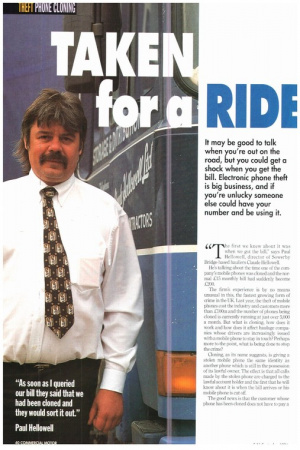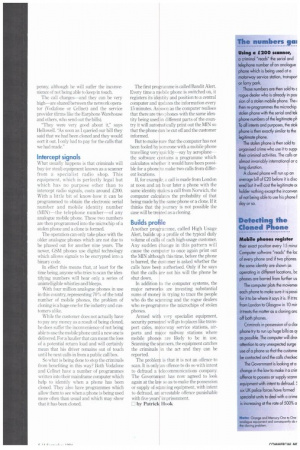D
Page 42

Page 43

If you've noticed an error in this article please click here to report it so we can fix it.
44 T 44 T
he first we knew about it was when we got the bill," says Paul Hellowell, director of Sowerby Bridge-based hauliers Claude Hellowell.
He's talking about the time one of the company's mobile phones was cloned and the normal £15 monthly bill had suddenly become £200.
The firm's experience is by no means unusual in this, the fastest growing form of crime in the UK. last year, the theft of mobile phones cost the industry and customers more than L100m and the number of phones being cloned is currently running at just over 5,000 a month. But what is cloning, how does it work and how does it affect haulage companies whose drivers are increasingly issued with a mobile phone to stay in touch? Perhaps more to the point, what is being done to stop the crime?
Cloning, as its name suggests, is giving a stolen mobile phone the same identity as another phone which is still in the possession of its lawful owner. The effect is that all calls made by the stolen phone are charged to the lawful account holder and the first that he will know about it is when the bill arrives or his mobile phone is cut off.
The good news is that the customer whose phone has been cloned does not have to pay a penny, although he will suffer the inconvenience of nut being able to keep in touch.
The call charges—and they can be very high—are shared between the network operator (Vodafone or Cellnet) and the service provider (firms like the Earphone Warehouse and others, who send out the bills).
"They were very good about it," says HeHowell. "As soon as I queried our bill they said that we had been cloned and they would sort it out. I only had to pay for the calls that we had made."
Intercept signals
What usually happens is that criminals will buy (or steal) equipment known as a scanner from a specialist radio shop. This equipment, which is perfectly legal but which has no purpose other than to intercept radio signals, costs around £200. With a little bit of know-how it can be programmed to obtain the electronic serial number and mobile identity number (MIN)—the telephone number—of any analogue mobile phone. These two numbers are then programmed into the microchip of a stolen phone and a clone is formed.
The operation can only take place with the older analogue phones which are not due to be phased out for another nine years. The newer, GSM phones use digital technology which allows signals to be encrypted into a binary code.
In effect this means that, at least for the time being, anyone who tries to scan the identifying numbers will hear only a series of unintelligible whistles and bleeps.
With four million analogue phones in use in this country, representing 70% of the total number of mobile phones, the problem of cloning is a huge one for the industry and customers alike.
While the customer does not actually have to pay any money as a result of being cloned, he does suffer the inconvenience of not being able to use the mobile phone until a new one is delivered. For a haulier that can mean the loss of a potential return load and will certainly mean that his driver remains out of touch until he next calls in from a public call box.
So what is being done to stop the criminals from benefiting in this way? Both Vodafone and CeMet have a number of programmes written into their mainframe computer which help to identify when a phone has been cloned. They also have programmes which allow them to see when a phone is being used more often than usual and which may show that it has been cloned. The first programme is called Bandit Alert. Every time a mobile phone is switched on, it registers its idaitity and position to a central computer and Opdates the information every 15 minutes. Aslsoon as the computer realises that there are to phones with the same identity being used; in different parts of the country it will autorhatically print out the MIN so that the phone Can be cut off and the customer informed.
But to make tire that the computer has not been fooled by onieone with a mobile phone travelling very iquickly—say by aeroplane— the software cbntains a programme which calculates whether it would have been possible for a phone. to make two calls from different locations.
If, for example, ii call is made from London at noon and an hour later a phone with the same identity makes a call from Norwich, the computer calculates the probability of that being made by the same phone or a clone. If it thinks that the journey is not possible the case will be treated as a cloning.
Builds profile
Another programme, called High Usage Alert, builds up a profile of the typical daily volume of calls of each high-usage customer. Any sudden change in this pattern will cause the computer to once again print out the MIN although this time, before the phone is barred, the 4ustomer is asked whether the calls have beet' authorised. Only if he says that the calls itre not his will the phone be shut down.
In addition to the computer systems, the major networks are investing substantial sums of moneir in trying to trace the people who do the scanning and the rogue dealers who re-prograninie the microchips of stolen phones.
Armed with vaty specialist equipment, security personnel will go to places like transport cafes, motorway service stations, airports and major railway stations where mobile phones are likely to be in use. Scanning the scanners, the equipment catches the criminals in the act and they can be reported.
The problem is that it is not an offence to scan. It is onlyan offence to do so with intent to defraud a telecommunications company. The Government has now agreed to look again at the law so as to make the possession or supply of summing equipment, with intent to defraud, an, arrestable offence punishable with five yeanf imprisonment.
E by Patrick Hook
















































































































